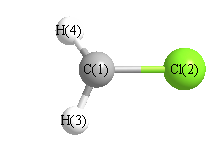Jump to
S1C2
Energy calculated at CCD/cc-pVDZ
| | hartrees |
|---|
| Energy at 0K | -498.768225 |
| Energy at 298.15K | |
| HF Energy | -498.486178 |
| Nuclear repulsion energy | 44.948417 |
The energy at 298.15K was derived from the energy at 0K
and an integrated heat capacity that used the calculated vibrational frequencies.
Vibrational Frequencies calculated at CCD/cc-pVDZ
| Mode Number |
Symmetry |
Frequency
(cm-1) |
Scaled Frequency
(cm-1) |
IR Intensities
(km mol-1) |
Raman Act
(Å4/u) |
Dep P |
Dep U |
|---|
| 1 |
A' |
3204 |
3066 |
7.85 |
|
|
|
| 2 |
A' |
1432 |
1370 |
14.81 |
|
|
|
| 3 |
A' |
859 |
822 |
35.76 |
|
|
|
| 4 |
A' |
341 |
327 |
56.79 |
|
|
|
| 5 |
A" |
3354 |
3209 |
0.16 |
|
|
|
| 6 |
A" |
1005 |
962 |
0.01 |
|
|
|
Unscaled Zero Point Vibrational Energy (zpe) 5098.0 cm
-1
Scaled (by 0.9567) Zero Point Vibrational Energy (zpe) 4877.3 cm
-1
See section
III.C.1 List or set vibrational scaling factors
to change the scale factors used here.
See section
III.C.2
Calculate a vibrational scaling factor for a given set of molecules
to determine the least squares best scaling factor.
Geometric Data calculated at CCD/cc-pVDZ
Point Group is Cs
Cartesians (Å)
| Atom |
x (Å) |
y (Å) |
z (Å) |
|---|
| C1 |
-0.012 |
1.128 |
0.000 |
| Cl2 |
-0.012 |
-0.590 |
0.000 |
| H3 |
0.137 |
1.628 |
0.959 |
| H4 |
0.137 |
1.628 |
-0.959 |
Atom - Atom Distances (Å)
| |
C1 |
Cl2 |
H3 |
H4 |
| C1 | | 1.7176 | 1.0918 | 1.0918 |
Cl2 | 1.7176 | | 2.4210 | 2.4210 | H3 | 1.0918 | 2.4210 | | 1.9178 | H4 | 1.0918 | 2.4210 | 1.9178 | |
 More geometry information
More geometry information
Calculated Bond Angles
| atom1 |
atom2 |
atom3 |
angle |
|
atom1 |
atom2 |
atom3 |
angle |
| Br2 |
C1 |
H3 |
117.280 |
|
Br2 |
C1 |
H4 |
117.280 |
| H3 |
C1 |
H4 |
122.871 |
|
Electronic energy levels
Charges, Dipole, Quadrupole and Polarizability
Jump to
S1C1
Energy calculated at CCD/cc-pVDZ
| | hartrees |
|---|
| Energy at 0K | -498.768154 |
| Energy at 298.15K | |
| HF Energy | -498.485931 |
| Nuclear repulsion energy | 44.981113 |
The energy at 298.15K was derived from the energy at 0K
and an integrated heat capacity that used the calculated vibrational frequencies.
Vibrational Frequencies calculated at CCD/cc-pVDZ
| Mode Number |
Symmetry |
Frequency
(cm-1) |
Scaled Frequency
(cm-1) |
IR Intensities
(km mol-1) |
Raman Act
(Å4/u) |
Dep P |
Dep U |
|---|
| 1 |
A1 |
3215 |
3076 |
6.06 |
|
|
|
| 2 |
A1 |
1431 |
1369 |
15.39 |
|
|
|
| 3 |
A1 |
863 |
826 |
34.17 |
|
|
|
| 4 |
B1 |
247i |
236i |
67.91 |
|
|
|
| 5 |
B2 |
3369 |
3223 |
0.00 |
|
|
|
| 6 |
B2 |
998 |
955 |
0.01 |
|
|
|
Unscaled Zero Point Vibrational Energy (zpe) 4814.4 cm
-1
Scaled (by 0.9567) Zero Point Vibrational Energy (zpe) 4606.0 cm
-1
See section
III.C.1 List or set vibrational scaling factors
to change the scale factors used here.
See section
III.C.2
Calculate a vibrational scaling factor for a given set of molecules
to determine the least squares best scaling factor.
Geometric Data calculated at CCD/cc-pVDZ
Point Group is C2v
Cartesians (Å)
| Atom |
x (Å) |
y (Å) |
z (Å) |
|---|
| C1 |
0.000 |
0.000 |
-1.125 |
| Cl2 |
0.000 |
0.000 |
0.590 |
| H3 |
0.000 |
0.963 |
-1.637 |
| H4 |
0.000 |
-0.963 |
-1.637 |
Atom - Atom Distances (Å)
| |
C1 |
Cl2 |
H3 |
H4 |
| C1 | | 1.7152 | 1.0907 | 1.0907 |
Cl2 | 1.7152 | | 2.4264 | 2.4264 | H3 | 1.0907 | 2.4264 | | 1.9262 | H4 | 1.0907 | 2.4264 | 1.9262 | |
 More geometry information
More geometry information
Calculated Bond Angles
| atom1 |
atom2 |
atom3 |
angle |
|
atom1 |
atom2 |
atom3 |
angle |
| Br2 |
C1 |
H3 |
117.988 |
|
Br2 |
C1 |
H4 |
117.988 |
| H3 |
C1 |
H4 |
124.025 |
|
Electronic energy levels
Charges, Dipole, Quadrupole and Polarizability
